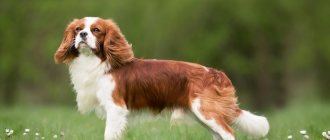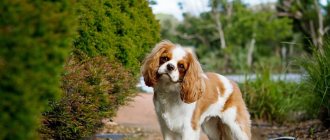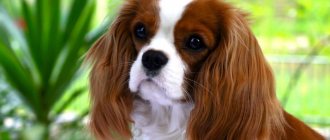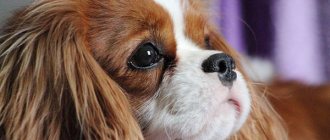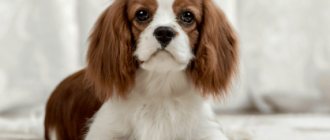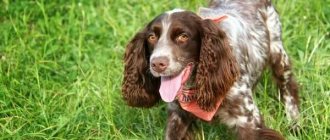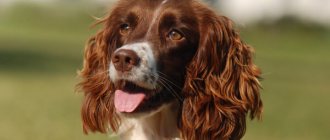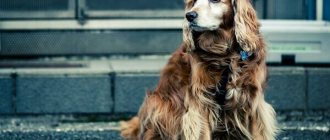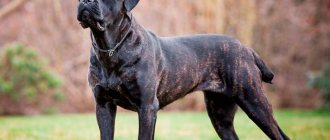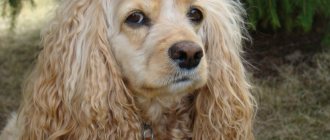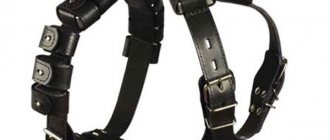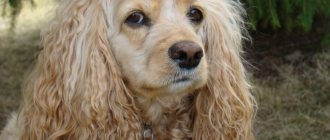The Cavalier King Charles Spaniel is a small toy dog. She has an expressive appearance and a good-natured, cheerful character. She can become a devoted friend, a companion for a lonely person or a family favorite. These dogs are affectionate, cheerful, sociable, and not at all aggressive. They get along well with any person and are not prone to dominance, so they are suitable for inexperienced owners. But before you get a Cavalier King Charles Spaniel, you need to learn everything about this breed. Reviews from owners and videos about these dogs will help you learn better about their pros and cons.
- Head
- Education and training
- Grooming
History of the Cavalier King Charles Spaniel breed
Cavalier King Charles Spaniel
Due to the similarity of names, the Cavalier King Charles Spaniel is often identified with the King Charles Spaniel. And yet, despite the common Asian ancestor, these are two independent breeds with significant differences in phenotype. Without going into the subtleties of selection, the Cavalier King is a thoroughly “redesigned” King Charles, born as a tribute to British canine traditions. At the same time, Tibetan spaniels are considered the progenitors of both breeds.
Around the middle of the 9th century, the European nobility became interested in the ancestors of today’s “kings” and “cavaliers”. Toy spaniels sat in the boudoirs of baronesses and duchesses, Titian and Van Dyck raced to paint their portraits, and the bloodthirsty tyrant Henry VIII even recognized the animals’ right to be at court. With the accession of Charles II to the British throne, the breed added the prefixes King and Charles to its name and began to enjoy an almost unlimited list of privileges. Why, spaniels were even allowed into the holy of holies - the British Parliament!
The King Charles family began to inevitably fade away with the coming to power of William III of Orange. The new monarch established his own rules at court, settling into his chambers a “party” of pugs, whom he sincerely adored. The rest of the London elite immediately rushed to imitate the preferences of the crowned lady, as a result of which short-faced, bug-eyed dogs came into fashion. Toy spaniel breeders also did not stand aside: in order to please picky aristocrats, they began crossing their own pets with pugs and Japanese chins. Ultimately, by the 20th century, the appearance of the animals had changed so much that only the most sophisticated specialist could recognize the former King Charles dogs in the snub-nosed, big-eyed dogs.
In the mid-20s, European breeders decided to revive the old type of English Toy Spaniels. Around the same time, the British Kennel Club approved a cash prize for the breeder who, within the next five years, manages to breed the classic King Charles variety. As expected, the promise of a reward fueled the interest of breeding specialists, and already in 1928 the first “specimen” of a King Charles Spaniel with a traditional European appearance was presented to the canine commission. The animal had an elongated muzzle and normally set eyes, bringing it closer to the dogs from the paintings of Edwin Landseer.
To avoid confusion in the future, the revived breed was given a new name. Thus, the Cavalier King Charles Spaniel clan branched off from the King Charles tribe. By the way, the prefix cavalier was not chosen by chance. During the English Revolution, this was the name given to supporters of King Charles I, under whom the breed truly flourished. In 1945, the Cavalier Kings were included in the registries of the CC, after which they began to gain popularity in other European countries. The favorites of the British monarchs made their way to Russia even before the revolution, although they began to be fully bred only in 1986.
For your information: over the years, fans of the Cavalier King Charles Spaniel breed have included Ronald Reagan, Johnny Depp, Frank Sinatra, Tary Hatcher, Natalie Wood and Hugh Hefner.
Positive traits of a dog
The list of advantages of the breed is difficult to complete: this breed is considered a successful combination of the advantages of a small size without characteristic problems such as a quarrelsome nature, soreness and uncontrollability:
- Cavaliers have a cheerful disposition, are good-natured, and are very attached to people . This is an ideal companion dog for children and older people, he is always ready to communicate and does not get tired of playing. It is ideal for a gentleman to be in a large family, where there are children of different ages for active games and elderly relatives, because the dog loves to sleep on the owner’s lap.
- A dog’s amiability is also evident in how easily it establishes contact with its relatives and other animals: it gets along well with all the pets in the house, and the saying about a cat and a dog will only be remembered as a joke.
- attractive appearance is an additional plus. The bright contrasting color attracts attention to the animal. Despite the long hair, the breed standard does not require much effort in cutting and grooming. All that is required is to cut off the excess hair between the toes, otherwise it may mat.
- A small dog does not require large expenses for food, does not take up extra space in the apartment, because it is smaller than some cats!
- The love of games and outdoor activities will not allow the owners to stay at home. Owners appreciate the intelligence of gentlemen. Unlike most small and stupid breeds, these spaniels are perfectly trainable and have an excellent memory. They learn more slowly than shepherd dogs or huskies, but they learn what they have learned quite quickly and reliably.
- The breed is perfect for novice owners . Even an accommodating grandmother can raise a smart dog that does not strive to become a leader. Unpretentious maintenance and a simple diet will not cause any difficulties. They just need to be loved.
Appearance of a Cavalier King Charles Spaniel
Both King Charles and Cavalier Kings belong to the English Toy Spaniel section, but, as mentioned earlier, have significant differences in appearance. Cavalier King Charles spaniels are larger (from 5.5 to 8 kg) and tall (up to 32 cm at the withers). The dogs' muzzles are moderately elongated, and their eyes lack the protrusion that their relatives inherited from pugs and other Asian breeds.
Cavalier King Charles Spaniel puppy
If the “kings” attract with their pronounced orientalism, then the “cavaliers” – with their unique grace and truly European charm. Silky, straight or slightly wavy fur, sparkling eyes and elegant movements make them ideal pets for all lovers of glamorous breeds. In addition, Cavalier Kings are born fashion models. You can shoot them sleeping, cutting through a dandelion lawn, or sitting in the arms of their owner and not worry about the shot being unsuccessful. These “British aristocrats” are photogenic anywhere, any time and in any mood.
Head
A small, flat skull between the ears with a shallow stop. Cone-shaped muzzle. The distance from the tip of the muzzle to the stop is no more than 3.8 cm.
Ears
The Cavalier King Charles Spaniel has long, high-set ears. The outer side of the ear flap is covered with abundant silky hair.
Eyes
Round, but without noticeable bulge. Large and very dark.
Nose
The lobe is large, uniformly black in color.
Jaws and teeth
Cavalier King Charles Spaniels have powerful jaws with a scissor bite (the lower teeth are completely covered by the upper teeth).
Neck
Normal length, with a slight bend.
Cavalier King Charles Spaniel muzzle
Frame
Compact body with a short lumbar area, flat back and normal chest width.
Limbs
The front and hind legs are moderately bony and smooth. The Cavalier King's paws are miniature, very soft, with the toes almost completely hidden by long dressing hair.
Tail
It is kept at the level of the back or slightly higher. Previously it was docked at ⅓, which is almost never practiced these days.
Wool
Silky to the touch and very long. Straight hair is considered the standard, but slight waviness of the coat is also quite acceptable.
Ruby Cavalier King Charles Spaniel
Cavalier King Charles Spaniel tricolor
Color
The following types of Cavalier King Charles Spaniel colors are officially approved:
- Blenheim (expressive chestnut spots on a white background);
- black and tan;
- ruby (rich red hue);
- tricolor (black with white and tan markings on the eyebrows, cheekbones, back of the legs, ears and under the tail).
Cavalier King Charles Spaniel black and tan
Cavalier King Charles Spaniel Blenheim
Disadvantages and possible defects
All individuals that have deviations from the breed standard are allowed to be considered defective. Of course, most external defects do not block an animal’s access to exhibition events, but the chances of it receiving an excellent mark are reduced to almost zero.
Another thing is developmental defects. A dog found to have them will not be accepted into any dog show. If we talk specifically about Cavalier Kings, they are disqualified for being underweight/overweight, non-standard colors and depigmented nose. Animals with a cleft lip, an atypical bite and an abnormal gait (hackney, ambling) will also have to forget about their exhibition career.
Description and standard
Cavalier Charles King Spaniels are petite, graceful and sweet-looking dogs that move freely and elegantly and are intended for indoor use only.
In accordance with the official breed standard for representatives of this breed:
- almost flat skull between the ears;
- a wedge-shaped muzzle, the length of which from the base of the shallow stop to the tip of the nose is about 3.8 cm;
- scissor bite;
- the eyes are large, round in shape, not bulging, the iris is dark;
- the ears are long, hanging, set high, abundantly covered with long, decorative hair;
- neck of medium length, slightly curved;
- the back is straight, the loin is short;
- chest of moderate depth, ribs well sprung;
- The limbs are straight, with moderate bones, the shoulders are sloping, the elbows fit tightly to the chest, the knee joints are well defined.
The coat is long, silky, slight waviness is acceptable, but not curly.
Photo of Cavalier King Charles Spaniel
Personality of the Cavalier King Charles Spaniel
Oh yeah!
Scratchies Cavalier King Charles Spaniels are the best healers of the blues and bad mood. They are literally obsessed with communicating with people and are completely unprepared to play the role of an outside observer in the family in which they live. Despite their generally not the most outstanding dimensions, there are always a lot of “gentlemen” in the house, as they are extremely curious and try to delve into everything that happens not only in front of their eyes, but also behind their backs.
The breed's need for human attention can be slightly annoying to the owner who does not have the opportunity to constantly contact the pet or who is tired of an overabundance of communication with him. That is why breeders recommend Cavalier King Charles Spaniels for large families with several generations of relatives. This will make it easier for the dog to find company without overloading one person with his sociability.
Cavalier King Charles Spaniel with children
Due to his natural curiosity and goodwill, the “gentleman” treats anyone well, even a stranger, so trusting him to guard your own home is obviously a bad idea. Bribing this playful “Englishman” is as easy as shelling pears: just chat gently with him or play a little. Such a feature of the breed as a ringing bark also does little to help the animal in security activities. Cavalier Kings often demonstrate their vocal talents in games than in the case of real danger, so forget about training this glamorous major to be a decent watchman.
In relation to other pets, Cavalier King Charles Spaniels have unparalleled charm. They are completely devoid of leadership ambitions and the desire to dominate everything that moves, so they will gladly hand over the “reins of power” to any four-legged creature that desires it. A purebred “gentleman” will have no problem getting along with another dog, cat or some exotic creature, provided that they do not try to take away his status as everyone’s favorite.
Cavalier King Charles Spaniel with cat
Advantages and disadvantages
Despite the fact that these dogs have an attractive appearance, a gentle character and are devoid of aggression, it is wrong to think that they are suitable for everyone without exception..
You should make your final decision about buying a pet after familiarizing yourself with all the advantages and disadvantages of the breed.
pros:
- devotion;
- agreeableness;
- lack of tendency to dominate;
- goodwill;
- occasional barking;
- cleanliness;
- intelligence and intelligence;
- possibility of keeping even in a small apartment;
- ability to get along with children and pets.
Minuses:
- need for constant attention;
- intolerance of loneliness;
- hyperactivity;
- need for regular long walks;
- a tendency to many hereditary diseases.
In addition, representatives of this breed are not suitable for use as watchmen and security guards.
Education and training
Cavalier King Charles Spaniels are very smart and easily comprehend all the intricacies of the educational process, which does not prevent them from turning on the “misunderstanding” mode from time to time. Owners often fall for this canine trick and bombard specialized forums with questions like: “Why doesn’t the Cavalier King follow commands?” The reason for this behavior lies not in obstinacy of character, but in banal boredom. Perhaps you simply went too far with the severity and duration of training, tiring the dog. Or they simply did not take into account the peculiarities of her temperament.
Cavalier King Charles Spaniel on a leash
Dog trainers assure that the Cavalier King Charles Spaniel must be trained through play and as affectionately as possible. Most of these British “aristocrats” are characterized by innate timidity, so if you raise your voice during training, your pet may refuse to participate in classes forever. It is also not forbidden to stir up interest in training. For this, a supply of your dog’s favorite treats is enough.
“Cavaliers,” despite their rather gentle and peace-loving character, are not alien to some robber habits at heart. For example, if a dog encounters a cat or rodent on a walk, it will definitely try to chase it. Moreover, not every such “hunt” ends with the happy return of the pet. Captivated by the excitement of pursuit, the Cavalier King can easily get lost, so the commands “Ugh!” and “Nearby!” with a pet should be learned in advance and as firmly as possible.
From the age of 4-5 months, show-class Cavalier King Charles Spaniels begin to be accustomed to the show stand. First, the animal's success is rewarded with a treat. And only after the puppy has formed a stable association: stand = treat, you can use the command “Stop!”
Note: experienced handlers do not recommend teaching the “Sit!” command to the Cavalier King Charles Spaniel. until the animal takes part in exhibition events. Confused in an unfamiliar environment, the pet may confuse the meaning of the commands and, instead of the stance required from it, give the opposite action.
Lover to lie on the sofa
Is he good with children and does he get along with other pets?
Cavalier Charles King Spaniels are friendly and affectionate dogs, which, combined with their activity and curiosity, makes them ideal pets for families with small children..
They get along well with kids and can spend a lot of time playing with them.
IMPORTANT!
Gentlemen will never offend children; on the contrary, they are always ready to protect them.
Representatives of this breed do not strive for leadership and dominance, so they easily find a common language with other pets, be they dogs, cats or rodents.
Maintenance and care
The first thing that owners of future champions should pay attention to is the flooring materials in the house.
On slippery parquet or laminate flooring, the puppy’s paws will move apart, which will become a prerequisite for the formation of incorrect gait and positioning of the limbs. It is best if the floor in the room is covered with a thick carpet or rugs, since Cavalier King Charles Spaniels are exclusively apartment dwellers. On the street they only walk and go to the toilet. If you sometimes have to leave your pet alone, buy him an enclosure and train him to sit in it. This way, the animal will be deprived of the temptation to chew your shoes or bite computer wires in your absence. Dogs of this breed are transported in cages, to which the pet will also have to be accustomed.
Important: do not use a cage or aviary as punishment in cases where the Cavalier King Charles Spaniel has bothered you too much with its excessive sociability. The dog will quickly realize what the true purpose of this accessory is and will earn itself an additional phobia.
Hygiene
Cavalier King Charles Spaniels are not groomed. You shouldn’t comb them too often either: the fur of representatives of this breed has a silky texture and almost does not tangle. Just brush your baby’s “fur coat” and enjoy freedom from this responsibility for 5-7 days. Another thing is the molting period. At this time, the hair of the “cavaliers” needs daily combing.
Washing a Cavalier King Charles Spaniel
You can smooth the animal's fur with a mitten: this will remove dirt, dust and dander from it. The furry “footprints” left by Cavalier King Charles Spaniels on sofas and carpets are also easy to deal with. Even the most powerful vacuum cleaner can suck up the hair of these dogs without any problems. In addition, the fur of the “Cavaliers” practically does not smell like a dog.
The frequency of bathing a dog is determined by its class. Show animals are washed once a week using a whole arsenal of products to smooth and nourish the hair, as well as giving it a noble shine. For pets, it is enough to give them a bath once a month with shampoo and conditioner to make their fur easier to comb. And don’t forget: the maximum permissible water temperature for a Cavalier King Charles Spaniel is 39 °C. The washed animal is dried with a towel and dried with a hairdryer. It is strictly not recommended to wrap your dog in a diaper and leave it to dry in it. Such experiments lead to dampening of the hair and its subsequent loss.
The most problematic organ of Cavalier King Charles Spaniels is the ears. Due to their hanging position, they are poorly ventilated, but they actively accumulate sulfur and dirt, so it is better to inspect and clean them more often. The pet's eyes should be checked every day, removing debris and mucus that accumulates in their corners with a cotton sponge. For inflammation of the eyes, you can wipe with chamomile infusion. If the inflammation is pronounced, it is not forbidden to drop a couple of drops of albumin onto the mucous membrane. But it is better to completely abandon the tea infusion and boric acid solution, which “home-grown ophthalmologists” recommend using on canine forums.
Representatives of this breed have their teeth brushed twice a week and their nails trimmed once every two weeks. After a walk, the Cavalier King Charles Spaniel's paws must be washed, and in winter they are lubricated with vegetable oil or cream to protect them from the toxic effects of reagents.
Walks
I found acorns for you here
Until 4 months of age, Cavalier King Charles Spaniels are taken for walks as often as possible to teach them to go to the toilet outside. Starting from the 4th month of life, the number of walks is reduced, but their duration is increased. It is important to remember that Cavalier Kings do not need intense physical activity or too long promenades, but simply standing with your pet under a tree will not work either.
It is better to walk the dog in areas where there is no asphalt. There the animal can run properly without the risk of overwork and injury to its paws. If you really want to walk with your “gentleman” on the sidewalks, do not exceed the optimal limit for such walks of 40 minutes.
On a walk
Feeding
“Natural”, “drying” or both – all these types of feeding are considered acceptable for Cavalier Kings. And yet, most experts prefer a natural diet as more healthy. When working on creating a menu for your own pet, keep in mind the fact that the Cavalier King Charles Spaniel is a breed prone to obesity. With an excess amount of high-calorie food, the dog will instantly gain weight, but it will not always be able to lose it.
We are waiting for something delicious!
The necessary products from the point of view of benefits for “cavaliers” are lean varieties of meat, cereals, and low-fat fermented milk. By the way, this breed is very partial to “vegan” dishes, so during the summer season, more often introduce vegetable stews, sliced fruits and salads into your pet’s diet. In addition, many Cavalier Kings readily eat berries, ground cucumbers and zucchini. From time to time it is useful to give dogs a yolk or quail egg.
Prohibited products:
- sweets;
- sausages;
- salty and spicy dishes;
- tubular bones;
- pork and any fatty meats;
- sour cream and cream;
- mushrooms;
- onion and garlic;
- legumes;
- pastries and white bread;
- River fish;
- pearl barley.
Owners who decide to feed their animals industrial food should not forget about the breed’s predisposition to food allergies. In this case, you can protect your pet only by carefully studying the composition of the food, so immediately discard varieties that contain “traces of the presence” of chicken or cereal crops.
This is probably for me
Om-Nom-nom
Toilet
Cavalier King Charles Spaniels are difficult to train to a litter box, so to meet their “needs” representatives of this breed have two options: the street or the diaper. To instill in your pet the habit of going to the toilet during a walk, he is taken outside immediately after eating or sleeping. If the method turns out to be ineffective, you can add a newspaper or a piece of fabric to it, which the dog used “little by little” at home. An animal interested in a familiar smell usually remembers its own needs and sits down next to the wet diaper. Never scold your Cavalier King for puddles in the apartment, but exaggerated praise for the dog for doing its “business” outside the house is very useful.
Nutritional Features
Representatives of this breed are unpretentious in food; they can be fed both natural products and industrial feeds..
The main advantage of natural feeding is that all nutrients are of natural origin and are better absorbed by the pet’s body.
However, it is impossible to create a balanced diet without the help of a veterinarian and without having certain knowledge of veterinary nutrition.
With this type of nutrition, the pet’s menu needs to include:
- lean meat;
- offal;
- rice, buckwheat, oatmeal;
- seasonal vegetables and fruits;
- boiled sea fish;
- eggs;
- dairy products.
It is forbidden to give these dogs:
- potato;
- melons, pears, citrus fruits;
- pork;
- butter;
- bones;
- sweets, baked goods;
- pickles, marinades;
- smoked meats and sausages;
- spicy, fried foods.
It is also useful to include flax seeds in the menu - they have a beneficial effect on the condition of the coat. In addition, with such a diet, the pet must be given additional vitamins and minerals.
Industrial feeds are convenient because they are easy to dose and use, and their use does not require additional intake of vitamin and mineral complexes, since the composition is already enriched with all necessary macro- and microelements.
These dogs are suitable only for high-quality premium, super-premium or holistic food. It is also necessary to ensure that the food is appropriate for the age, health and physiological state of the pet.
The most suitable diets are manufactured by the trademarks Go, Probalance, Savarra, Royal Canin, Pro Plan, Acana.
You should not mix both types of food - this negatively affects the digestion of dogs.
Menu for the week
| Day of the week | Menu |
| Monday | 300 g beef, 50 g greens, 100 g oatmeal, 100 g yogurt, 150 g vegetables |
| Tuesday | 300 g boiled fish, 100 ml natural yogurt, 100 g vegetables, 50 g cottage cheese, 150 g buckwheat porridge |
| Wednesday | 100 ml kefir, 50 g herbs, 350 g offal, 100 g cottage cheese and 100 g vegetables |
| Thursday | 120 g cottage cheese, 30 g greens, 1 egg, 250 g beef, 200 g vegetables, 100 g rice porridge |
| Friday | 100 ml kefir, 50 g herbs, 350 g offal, 100 g cottage cheese, 100 g vegetables |
| Saturday | 250 g of boiled sea fish, 100 ml of natural yogurt, 100 g of vegetables, 100 g of cottage cheese and 150 g of buckwheat porridge |
| Sunday | 250 g beef, 50 g greens, 100 g oatmeal, 100 g cottage cheese, 200 g vegetables |
Health and Diseases of Cavalier King Charles Spaniels
All hereditary diseases of Cavalier King Charles Spaniels are the end result of so-called line breeding and an overly limited genetic base. The first on the list of ailments that affects about half of the “cavaliers” aged 5 years and older is myxomatous valve degeneration or prolapse. The second scourge of the breed is syringomyelia (Chiari syndrome). An animal that has inherited this disease experiences discomfort and severe pain in the cervical spine, which in the absence of timely treatment leads to “twisting of the neck.”
Episodic falling syndrome is more difficult to diagnose than the two previous ailments, which does not prevent it from affecting a huge number of animals. The behavior of Cavalier Kings suffering from this disease is somewhat similar to the habits of dogs that have suffered a back injury. They freeze in place for a long time, arch their back when running and pull up their limbs when lying on their side. Another weak point of the breed is the joints. With age, many "gentlemen" develop patellar instability, and this most often occurs in bitches. Dry eye and curly coat syndromes, which are very difficult to treat, seriously spoil the lives of pets.
Difference from spaniel
The division of Cavaliers and Charles Kings into 2 independent breeds is not accidental - there are a number of differences between these dogs:
- Cavaliers have a rather long nose, while Charles Kings are more snub-nosed;
- the Charles Kings have a dome-shaped skull, while the Cavaliers have almost flat skulls;
- According to the standard, cavaliers have a scissor bite, while kings have an undershot bite.
In addition, Cavaliers are slightly larger than Charles Kings, but they cannot be used for work.
How to choose a puppy
When choosing a Cavalier King Charles Spaniel puppy, you can follow the same principles as when buying any other purebred dog.
- Do not take babies from nurseries that are unsanitary and disorderly.
- To insure yourself against purchasing a sick animal, ask the breeder for the results of tests aimed at identifying genetic diseases in the puppy (dry eye syndrome, curly hair, occasional falls).
- The temperament of Cavalier King Charles Spaniels is not gender dependent. Both females and males of this breed are equally affectionate and affectionate to their owner, so choose an animal according to your own preferences.
- Get to know the puppy's parents and their pedigree to avoid purchasing an inbreeding animal (from closely related individuals).
- Choose a playful, inquisitive baby who shows a keen interest in toys. Lethargy and hesitation in Cavalier King Charles Spaniel puppies indicate that they are physically and mentally exhausted.
Color variations
The breed standard strictly regulates the possible coat colors of Cavalier Charles King Spaniels and allows only four color options.
Blenheim
The most common color . On the main white-pink (pearl) color there are spots of red-brown shades.
In the drawing of the classic version, the ears and cheeks are painted red; the spots on the body can be of any shape, but symmetry is desirable.
There should be 2 adjacent triangular shaped marks on the head, resembling an hourglass . It is acceptable to have a Blenheim mark on the forehead - a small red spot.
Ruby
The coat is a solid deep red color, the presence of white or black hairs is unacceptable. The skin is pigmented black.
Tricolor
The main color of the coat is pearl, rather large black spots affect the body, ears and forehead. There should be a white mark on the head that goes down to the muzzle and lips, and red marks above the eyes and on the cheeks.
A small amount of red hair on the forearms is acceptable.
Black
The coat is deep black with reddish tan on the eye sockets, cheeks, ears, chest, paws and groin area. White color is not acceptable. The nose, eyelids, outer lip line and paw pads are pigmented black.
Photos of Cavalier King Charles Spaniel puppies
How much does a Cavalier King Charles Spaniel cost?
The cost of Cavalier King Charles Spaniel puppies directly depends on their pedigree and external parameters (class). Domestic breeders have an average price tag for a baby with a veterinary passport and RKF metric - 30,000 - 35,000 rubles. Prices for individuals with a standard appearance, promising to collect all conceivable and inconceivable championship titles in the future, start from 50,000 rubles. Traditionally, the most expensive are puppies from interbreeding (male and female from different countries). Such pets can cost 65,000 rubles and more.
